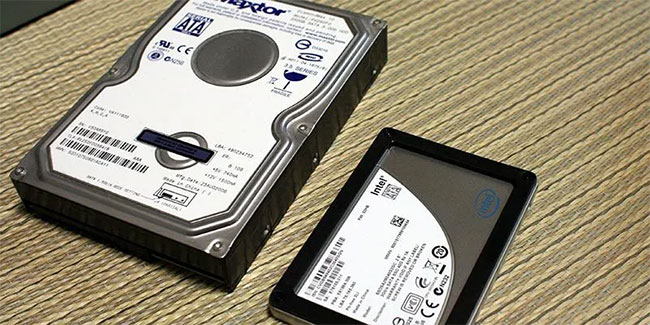Is Hibernate harmful to PC?
Many of us don't think much about putting our PC or laptop into Hibernate mode. However, this is an important capability of computers and Windows laptop manufacturers have included it as an indispensable parameter. Hibernate mode was created due to the need to keep the computer 24/7 without wanting to drain the battery or to ensure the system is not affected by a power failure, unlike Sleep mode.
However, a question arises. Does Hibernate have a negative impact on computers compared to normal shutdown? How often should you use the hibernate option? To answer these questions, you need to learn about how Hibernate mode works, its impact on PC performance, and whether it will harm the PC in the long run.
How does Hibernate work?
Hibernate refers to an energy mode in a laptop or notebook (very rarely in the case of desktops). This mode is designed to save energy by saving any open content to the storage drive. These are non-volatile storage media, because they are not easily lost data.
 Hibernate mode works similar to the process of off / restart
Hibernate mode works similar to the process of off / restart Hibernate mode works similar to the process of turning off / restarting, because the laptop does not require constant power to recover data. This mode ensures your computer's resources are protected in unpredictable situations. After restarting, the device is in the exact same state as when you left the computer before hibernating.
Hibernate mode is the opposite of Sleep (in which the laptop immediately switches to RAM and enters low power mode). Check out the article: How is Sleep and Hibernate different and when to use it? For more details.
Enable Hibernate mode on PC or laptop
Hibernate mode is supported in all versions of Windows. Refer to the following articles for details on how to do this:
- Instructions to enable / disable Hibernate mode on Windows 10
- Turn off, turn on Hibernate in Windows 7
The effect of Hibernate mode on PC performance and system health
Despite its potential to save power, Hibernate mode was previously thought to be harmful to hard drive performance over time. But things have changed a bit and today, you can use Hibernate mode much more often without causing any negative effects.
But eventually Hibernate is bad for PC? The answer depends on the type of hard drive you have. With HDDs, basically, Hibernate freezes all PC actions and stores this state securely on the hard drive in a giant hibernation file, called hiberfil.sys in Windows systems.
 Hibernate freezes all PC actions and stores this state securely on the hard drive
Hibernate freezes all PC actions and stores this state securely on the hard drive In HDD, the file size of hiberfil.sys may be close to that of system RAM. Depending on the number of applications running, the more RAM you have (16GB), the more data will be automatically copied to the hard drive. However, the benefit is that Hibernate consumes less power on laptops.
Basically, the decision to put the HDD into hibernation is a trade-off between maintaining power levels and decreasing hard drive performance over time.
 The decision to put the HDD into hibernation is a trade-off between maintaining power levels and decreasing hard drive performance over time.
The decision to put the HDD into hibernation is a trade-off between maintaining power levels and decreasing hard drive performance over time. However, for people with laptops equipped with SSDs, hibernation has little negative impact. Because SSDs do not have moving parts like traditional hard drives, nothing will be damaged. In addition, because SSDs are known to have a long life, your system does not experience the common wear and tear of HDDs.
Frequency of hibernation is reasonable?
As mentioned above, hibernation has less impact on SSD than HDD. However, even modern hard drive systems can only occasionally hibernate. Putting the computer into hibernation will not reduce performance much, if you do it once a week or so.
With these systems, you should only hibernate based on need. For example, when you leave your computer for 12 to 24 hours and have to continue everything without turning off or restarting. In other cases, it is better to turn it off completely and properly.
With SSD systems, you can be more comfortable, because only the last state is written to the drive and the machine shuts down smoothly. It won't take long to put your PC into hibernation and wake it up. A small drawback to hibernation, even with an SSD, is that the PC settings are not usually restored like when the PC is shut down and restarted properly.
If you need quick access to Hibernate, you can add the Hibernate option to the Start menu. On the other hand, if you do not use this mode, you can disable it to save storage space.
 How to determine if a Dell or Lenovo PC is compatible with Windows 10 May 2020 Update
How to determine if a Dell or Lenovo PC is compatible with Windows 10 May 2020 Update What is Apple HomeKit? How to use Apple HomeKit?
What is Apple HomeKit? How to use Apple HomeKit? The Computex 2020 event was officially canceled
The Computex 2020 event was officially canceled Microsoft automatically installs Windows 10 on some PCs without users' permission
Microsoft automatically installs Windows 10 on some PCs without users' permission How to find and open files with Command Prompt
How to find and open files with Command Prompt How to Make Illuminated Manuscripts
How to Make Illuminated Manuscripts